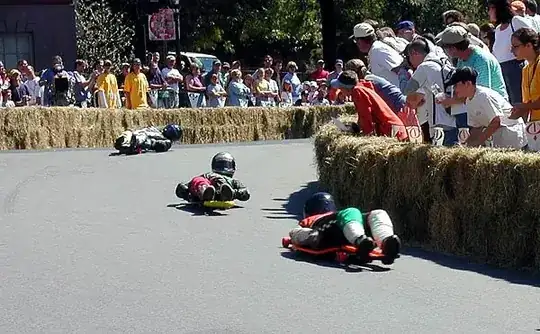Expanding on my comment on Renan's fine answer, as I think there is more to that story...
many sources cite untrained people can sustain forces of up to 4 to
6g before passing out, which is more than Jupiter's surface gravity
- Quote from Renan's answer
The Caveat
It should be noted the "4 to 6g before passing out" is specifically for an acceleration in the direction from your head to your feet. Different angles produce different results. That many Gs in the opposite direction, such as if you were to do a handstand at that same location, would result in blood vessels bursting in your eyes and eventually blindness.
That many Gs in a perpendicular direction, from your front to your back, would be much more tolerable and we can sustain way more Gs in that direction. This is the direction that we experience g-forces when we accelerate in a car.
The Adaptation
Perhaps we could adapt to the high-G forces by simply lying down all the time. We could crawl around on our backs. Or perhaps we would generally be lying on something modeled after a street luge board.

Image from Wikipedia
We would probably build something like that and put small motors on them.
We could cruise around our Jupiter-station on something like that, and keep all objects we want to pick up and manipulate very low close to the floor.
Rooms would be very short with ceilings being only 3 feet (1 meter) from the floor. Computer monitors would be attached to the ceiling so that you could see them easily while in the lying position.
Keyboards would be wireless and installed into the board next to you so that you could use them in the position where your arms naturally rest, and they would also be used to control the luge-like board.
Adapting like this would allow us to tolerate that many Gs for a much more extended time than using our usual standing and walking posture.
The Supporting Technical Sources
From this medicaldaily article I found the following...
It's difficult to calculate the exact level of G-force that would kill
a human, because the duration of exposure is such an important factor.
There are isolated incidents of humans surviving abnormally high
G-forces, most notably the Air Force officer John Stapp, who
demonstrated a human can withstand 46.2 G's. The experiment only went
on a few seconds, but for an instant, his body had weighed over 7,700
pounds, according to NOVA.
As they correctly noted, the duration of exposure is significant. I notice the same record is in the Wikipedia page for G-force and it does specify that John Stapp's experiment was horizontal acceleration, not vertical. The Wikipedia page also notes that some others have survived even higher G-forces, but again this is all very short duration.
There is another Stack Exchange question asking about long duration G-force exposure, and a useful answer here. It suggests there is not enough research in this area which is what I expected, but it looks like the best supporting experimental evidence found by that answer was a continuous high-G environment that lasted at most 7 days at 1.5 G, after which no immediate ill effects were found. There are multiple citations in that answer which you could use to dig further.
Also note that the health problems of simply lying down almost all day every day permanently are an issue regardless of the high Gs and can affect us even on Earth at 1 G.
Summary
We might not have enough research to demonstrate that 4-6 Gs is survivable for long durations, but we do have research suggesting that 1.5 Gs for a week might cause no problems. If we also accept that 1) since we don't have known experiments of higher G-forces or longer exposures, we can unsafely assume that you could probably push that a bit stronger and longer before seeing ill effects, and 2) that you can probably condition and train people to withstand more Gs or for longer duration, then we are getting close to the conditions of Renan's suggested elevation at 4-6 Gs.
And if you take the 2.5G Jupiter G-force suggestion in the answer by Artemijs, that only makes this even more possible and for even longer, possibly months or years.
So if you take my adaptation suggestions, you could probably do your Jupiter mission at Renan's elevation for at least some number of days or weeks, and if we are underestimating human resiliency then maybe even longer.
And we get to race street luge boards around a space station!
